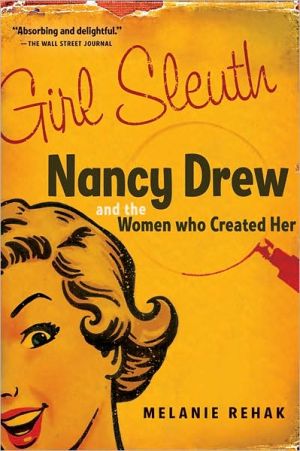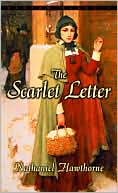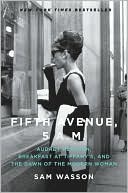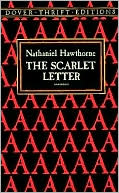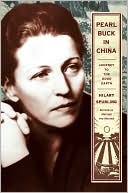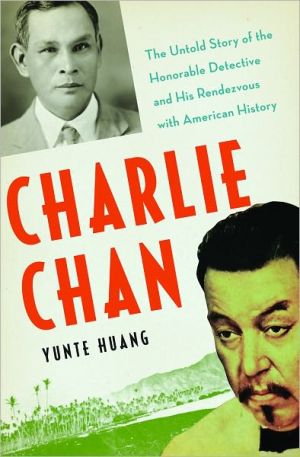Girl Sleuth: Nancy Drew and the Women Who Created Her
A plucky “titian-haired” sleuth solved her first mystery in 1930. Eighty million books later, Nancy Drew has survived the Depression, World War II, and the sixties (when she was taken up with a vengeance by women’s libbers) to enter the pantheon of American girlhood. As beloved by girls today as she was by their grandmothers, Nancy Drew has both inspired and reflected the changes in her readers’ lives. Here, in a narrative with all the vivid energy and page-turning pace of Nancy’s adventures,...
Search in google:
In 1930 a plucky girl detective stepped out of her shiny blue roadster, dressed in a smart tweed suit, ready to restore a stolen inheritance to its rightful owner. Tied up by the villains, she managed to free herself and bring them to justice - all while wearing a pencil skirt and high heels. Eighty million books later, Nancy Drew has survived the Depression, World War II, and the sixties (when she was taken up with a vengeance by women's libbers), and emerged as beloved by girls today as she was by their grandmothers. Now, in a narrative with all the fast-paced thrill of one of Nancy's adventures, Melanie Rehak solves a page-turning literary mystery: Who created Nancy Drew? And how did she go from pulp heroine to American icon?With ebullience, wit, and a wealth of little-known source material, Rehak weaves a behind-the-scenes history of Nancy and her groundbreaking creators. Taking us from The Secret of the Old Clock to The Secret of the Spa, Rehak tells all about our fearless sleuth - including the fact that both Nancy and her "author," Carolyn Keene, were invented by Edward Stratemeyer, a dime-novel genius who also created the Bobbsey Twins and the Hardy Boys. But Nancy Drew was actually brought to life by two remarkable women: original author Mildred Wirt Benson, a convention-flouting Midwestern journalist, and Harriet Stratemeyer Adams, a wife and mother who transformed herself into a CEO to run her father's company after he died. Together, Benson and Adams created a character that has inspired generations of girls to be as strong-willed and as bold as they were.Melanie Rehak will send you back to your old Nancy Drews—but thanks to GIRL SLEUTH you'll never read them the same way again.The New York Times - Kate ArthurAs a literary biography, Girl Sleuth is necessarily tangled, since the Nancy Drew mysteries, now 75 years old, had numerous parents. But Rehak does a terrific job of bringing to life the writers and editors who constituted Carolyn Keene, the pseudonymous author of the series.
The Stratemeyer Clan\ These suggestions are for a new series for girls verging on novels. 224 pages, to retail at fifty cents. I have called this line the "Stella Strong Stories," but they might also be called "Diana Drew Stories," "Diana Dare Stories," "Nan Nelson Stories," "Nan Drew Stories" or "Helen Hale Stories" . . .\ Stella Strong, a girl of sixteen, is the daughter of a District Attorney of many years standing. He is a widower and often talks over his affairs with Stella and the girl was present during many interviews her father had with noted detectives and at the solving of many intricate mysteries. Then, quite unexpectedly, Stella plunged into some mysteries of her own and found herself wound up in a series of exciting situations. An up-to-date American girl at her best, bright, clever, resourceful and full of energy.\ ***\ IN SEPTEMBER of 1929 children's book mogul Edward Stratemeyer sent one of his inimitable typed memos to Grosset & Dunlap, his longtime publisher, describing a new line of books he hoped they would launch the following spring. Though he proved to have an uncharacteristically tin ear when it came to choosing a name for his heroine- any other option on his list of possibilities had a better ring to it than "Stella"-his sense of her life and her intrepid personality were flawless. While they had no way of knowing that Stratemeyer's girl detective would eventually become a celebrity not only in the children's book world but in the world at large, Grosset & Dunlap's editors certainly knew a good thing when they saw it. They accepted Stratemeyer's series on the basis of his memo, which also included brief plotlines for the first five books in the series, and his reputation, which, by the time "Nan Drew" burst on to the scene with her fashionable outfits and boundless intelligence, had been the source of admiration and envy-and a great fortune for Stratemeyer-for several decades. When his latest proposal reached their Manhattan office, he had been writing for children for more than forty years and was so steeped in the idiom of his chosen genre that he had given even the events of his own life-which were rather straightforward and businesslike when it came down to it-the sheen and thrill of a juvenile story.\ This transformation had begun at the moment of his first serious publication in a children's story paper in November of 1889. It was a fanciful tale called "Victor Horton's Idea," and it told of a boy who went out into the world to live life-unsuccessfully, it would transpire-like the characters in his favorite dime novels.\ Victor was fifteen years old, naturally bright and lively, and if he had not held so high of an opinion of himself, he would have been a first-rate lad.\ Besides being conceited, Victor was dissatisfied with the quietness of country life. He longed to go forth into the great world and achieve fame and fortune.\ Now, though this idea is often a very laudable one, it was not so in the present instance. Victor's idea upon the subject had been gathered wholly from the pages of numerous dime novels and disreputable story papers loaned him by his particular crony, Sam Wilson, and was, therefore, of a deceptive and unsubstantial nature, and likely to do more harm than good.\ The details of Victor's exploits appeared in installments over five weeks, crammed into the narrow columns of a richly illustrated black-and-white children's broadsheet out of Philadelphia called Golden Days for Boys and Girls (subscription price $3 per annum). Alongside them ran informative articles with titles like "How to Make a Guitar" ("Those who have read the articles on 'Violin Making' and have succeeded in making one would, perhaps, like to make a guitar if they knew what a simple matter it is"); interesting trivia; and true stories about heroic rescues of humans by dogs.\ Stratemeyer was twenty-six years old, tall, slender, and bespectacled, with a brushy mustache, dark hair combed back off a high forehead, and a preternatural instinct for the arc of a good tale for young people. He had, according to one news report, "a scholarly appearance . . . and his eyes are a trifle contracted from constant application to his work." Indeed, in person, Stratemeyer betrayed no signs of the flights of fancy that had produced Victor and would go on to invent countless other young scalawags, heroes, and heroines over the next forty years. As one reporter would later describe him, he was "a tranquil-faced man, with kind, good-humored eyes . . . [and] a curiously deliberate manner of speaking. One doubts if he has ever been hurried into a decision or ever given an answer to a question without earnest consideration." He also had a healthy sense of perspective on his chosen field. By the end of Victor Horton's travails, the young man announces to his hapless friend Sam: "Dime novels are a first-class fraud!"\ Nonetheless, they were the field that Stratemeyer aimed to get into. Myth had it that he had written "Victor Horton's Idea" on a sheet of brown package paper during quiet moments while clerking at his brother's tobacco store in Newark, New Jersey. In spite of having recorded very clearly in his own notes that he had written the story at home, Stratemeyer, knowing better than most the value of a good yarn, repeated the entertaining falsehood about its conception whenever he was asked to. As one news feature of the era printed it, complete with the final triumph of will and self-knowledge over discouragement:\ His initial long story-18,000 words-was written on store wrapping paper and later copied onto white paper. The author, who was then twenty-five, was not satisfied with it so he laid it aside. After a year . . . he revised the manuscript carefully and sent it to Golden Days. The check for $75 he received Stratemeyer bore proudly to his father, Henry J. Stratemeyer. "Look at this," he said. The father, who had told him he was wasting his time writing the tale and might be better engaged in a more useful activity, regarded the check, then jerked up his glasses. "Why, it's a check made out to you!" he exclaimed. Stratemeyer explained he had received it for the story the parent had tried to discourage. "Paid you that for writing a story?" his father repeated. "Well, you'd better write a lot more of them."\ In addition to his paycheck, Stratemeyer received something even more valuable: some sage-not to mention prophetic-advice from the editor of Golden Days. "I think you would become a good serial writer if you were to know just what was required, always remembering that each 'to be continued' must mark a holding point in the story." The young author not only took these words fully to heart, but would incorporate them, practically verbatim, into his own advice to writers for years to come.\ Born on October 4, 1862, Edward Stratemeyer was the youngest of six children, three of them half-brothers, and all of them musically or artistically talented. His father, Henry Julius Stratemeyer, had come to the United States from Germany in 1837, along with a wave of German immigrants that only got larger and larger as the nineteenth century progressed. Many of them, including Henry Stratemeyer, headed out to the California coast in search of the shiniest, most tempting American dream of them all: gold. By 1851, though, Henry had mined more fool's gold than the actual metal, and he headed back east to Elizabeth, New Jersey, to visit his brother, George, also an émigré; his brother's wife, Anna; and the couple's three sons. Surrounded by family, Henry decided to stay in Elizabeth and settled into shopkeeping, advertising himself as a "wholesale and retail dealer in tobacco, cigars, snuff and pipes."\ Two years after his brother's arrival in New Jersey, George Stratemeyer was stricken during a cholera epidemic. Knowing death was near, he asked Henry to stay in America and look after his family. Henry agreed, and in 1854, not long after George's death, he married his brother's widow, making his three nephews into his stepsons. Henry and Anna went on to have three more children: Louis Charles, born in 1856; Anna, born in 1859; and Edward, born in 1862. The family was well established in the cultured, comfortable merchant circle of Elizabeth and was barely touched by the War Between the States. Neither a military man nor a willing volunteer, the elder Stratemeyer had no trouble staying out of it.\ As they grew, the Stratemeyer boys were put to work in their father's thriving tobacco store, in order that he might teach them the basics of commerce and, especially, entrepreneurship. The children also received musical training. Edward's sister, Anna, who would become an accomplished pianist, received her entire schooling at a prominent conservatory in town. Edward, on the other hand, was educated in the public schools of Elizabeth, and though he had an ear for music, too, preferred language. "You ask when I first wanted to become an author," he wrote to an acquaintance in 1919. "I think I must have been about six years old when I attempted to write my first story." He displayed an early interest in publishing, as well, running around his neighborhood with a toy printing press-an accoutrement that was all the rage at the time-turning out items for the pleasure of his friends and family. He would interview local residents about the goings-on in their lives during the week, then print up their answers in a newspaper that he sold back to them, at the price of one cent, on Saturday mornings.\ Two chapbooks followed, with the entertaining, inscrutable titles That Bottle of Vinegar (1877) and The Tale of a Lumberman as Told by Himself (1878). The latter included, in bold black-and-white, the confident statement "E. STRATEMEYER PUBLISHER" on its cover. Stratemeyer was just sixteen years old, but he had grown up reading the books of Oliver Optic (the nom de plume of William T. Adams) and Horatio Alger, the two predominant boys' fiction authors of the period, and the adventure-filled, rags-to-riches stories, as well as their action-packed dime-novel counterparts, left an impression on him that lasted well into his adult years. As he recalled fondly in an interview: "I had quite a library, including many of Optic's and Alger's books. At seven or eight, when I was reading them, I said, 'If only I could write books like that I'd be the happiest person on earth.'"\ Stratemeyer graduated from Elizabeth High School, the valedictorian of his class of three. Afterward, as was the norm for even a middle-class boy-only 1 percent of Americans attended college in the 1870s-he received two years of private tutoring in rhetoric, composition, and literature. He continued to combine clerking in a tobacco store-his brother Maurice's this time-with writing, refining his stories, and selling them to the story papers that were appearing all over the country, like the Penny Magazine (which paid him $1 for "A Horrible Crime"), the Experiment, and the Boys' Courier.\ Copyright © 2005 by Melanie Rehak\ All rights reserved. No part of this publication may be reproduced or transmitted in any form or by any means, electronic or mechanical,\ including photocopy, recording, or any information storage and retrieval system, without permission in writing from the publisher.\ Requests for permission to make copies of any part of the work should be mailed to the following address: Permissions Department,\ Harcourt, Inc., 6277 Sea Harbor Drive, Orlando, Florida 32887-6777.
The Stratemeyer Clan 1Mildred 33Alma Mater 48Hawkeye Days 73Nell Cody, Helen Hale, Diana Dare 90Nancy Drew Land 110Syndicate for Sale 126An Unfortunate Break; or, The Cleveland Writer Comes into Her Own 140Motherhood and Nancy Drew 168"They Are Nancy" 197The Kids Are Hep 224Nancy in the Age of Aquarius 254Will the Real Carolyn Keene Please Stand Up? 288Acknowledgments 315Notes 318Bibliography 351Index 355
\ From Barnes & NobleNancy Drew has been through it all. Since she opened shop in 1930, this plucky "girl detective" has survived a Great Depression and a Cold War; outwitted Nazi spies; unmasked shady mediums; tracked down stories with an alacrity that Bernstein and Woodward would envy; rescued pets in distress; and recovered lost treasures. And, best of all, Nancy has aged only two years since her debut! In Girl Sleuth, Melanie Rehak pays homage to a pint-sized heroine beloved by both feminists and conservatives.\ \ \ \ \ Boston Phoenix"Rehak chronicles a character who influenced at least two generations of women in a highly readable, exhaustive book."\ \ \ Kate ArthurAs a literary biography, Girl Sleuth is necessarily tangled, since the Nancy Drew mysteries, now 75 years old, had numerous parents. But Rehak does a terrific job of bringing to life the writers and editors who constituted Carolyn Keene, the pseudonymous author of the series.\ — The New York Times\ \ \ \ \ Publishers WeeklyThe intrepid Nancy Drew has given girls a sense of their own power since she was born, Athena-like, from the mind of Edward Stratemeyer in 1929 and raised after his death in 1930 by his daughter Harriet Stratemeyer Adams and Mildred Wirt Benson, a journalist who was the first to write the novels under the pen name Carolyn Keene. Poet and critic Rehak invigorates all the players in the Drew story, and it's truly fun to see behind the scenes of the girl sleuth's creation, her transformation as different writers took on the series, and the publishing phenomenon-the highly productive Stratemeyer Syndicate machine-that made her possible. Rehak's most ambitious choice is to reflect on how Nancy Drew mirrors girls' lives and the ups and downs of the women's movement. This approach is compelling, but not particularly well executed. Rehak's breathless prose doesn't do justice to the complexity of the large social trends she describes, and tangents into Feminism 101 derail the story that really works-the life of a publishing juggernaut. All the same, Stratemeyer himself would undoubtedly say that the story is worth telling. Drew fans are likely to agree. 8 pages of b&w photos not seen by PW. Agent, the Wylie Agency. (Sept.) Copyright 2005 Reed Business Information.\ \ \ \ \ Children's LiteratureA chilly day calls for a cup of hot tea and a good mystery, especially if it features the secret story behind America's favorite female detective. Girl Sleuth: Nancy Drew and the Women Who Created Her will appeal to all those teens and adults who avidly followed Nancy's adventures in their elementary-school years. Author Melanie Rehak probes beneath the fictive Nancy and her equally fictive author Carolyn Keene (both the brainchild of Edward Stratemeyer, creator of the Hardy Boys) to reveal the two spunky women who helped give the character her strong personality. With more than eighty million books sold, Nancy remains as popular today as in her 1930 debut The Secret of the Old Clock. Why? Rehak explores how Nancy has changed with the times without sacrificing her independence and integrity. Forget scholarly tome, this book is a real page turner! 2005, Harcourt, Ages 12 up. \ —Mary Quattlebaum\ \ \ \ \ Library JournalThe story behind everyone's favorite girl sleuth. Copyright 2005 Reed Business Information.\ \ \ \ \ School Library JournalAdult/High School-As much a social history of the times as a book about the popular series, this is a fun title that will appeal to older teens who remember the series fondly. In 1930, she arrived in her shiny blue roadster and she has remained a part of the children's book scene ever since. While Nancy may have been the brainchild of Edward Stratemeyer, creator of the successful Stratemeyer Syndicate, it was the devotion of Harriet, his daughter, and syndicate writer Mildred Wirt Benson who brought her to life. The series succeeded beyond anyone's wildest dreams but things were not always peaceful in River Heights. Rehak does a good job of explaining the intricacies of the Stratemeyer Syndicate and the sometimes-rocky relationship between these two strong women, each of whom felt a sense of ownership of the girl detective. Those who followed the many adventures of Nancy Drew and her friends will be fascinated with the behind-the-scene stories of just who Carolyn Keene really was.-Peggy Bercher, Fairfax County Public Library, VA Copyright 2006 Reed Business Information.\ \ \ \ \ Kirkus ReviewsThe true story behind the creation of the resilient fictional girl detective. Even though the Nancy Drew mysteries subsist, according to poet and critic Reha, on "formulaic dialogue, totally implausible escapes and absurd plot twists," readers admire and identify with the character of Nancy herself: "her bravery, her style, her generosity, and her relentless desire to succeed." The author embarks on her own bit of energetic sleuthing into the life of children's book mogul Edward Stratemeyer, the man behind the Nancy Drew, Rover Boys and Bobbsey Twins books. In 1905, he formed the lucrative Stratemeyer Syndicate, which essentially outlined new series and handed them out to ghostwriters so that "no one would ever be the wiser about who was actually doing the writing." The character of Nancy Drew grew out of Stratemeyer's success with earlier titles featuring gutsy, brainy, proto-modern heroines Dorothy Dale and Ruth Fielding, as well as the mystery-solving Hardy Boys. Stratemeyer farmed out the new mystery series for girls to eager Iowa journalist Mildred Wirt, who had fashioned the Ruth Fielding titles, and plucky Miss Nancy Drew made her debut on April 28, 1930, "dressed to the nines in smart tweed suits, cloche hats, and fancy dresses." Wirt seems to have endowed the early Nancy Drew with her own indomitable spunkiness, while the series' later ghostwriter, Stratemeyer's Wellesley-educated daughter Harriet, instead emphasized Nancy's pedigree and correct bearing. (Sidekicks Bess and George were the brainchildren of Stratemeyer's intrepid and loyal secretary, Harriet Otis Smith.) The series was an instant bestseller for Grosset & Dunlap at 50 cents per copy, and Wirt would end up writing adozen of the titles. In an unfortunate but perhaps inevitable denouement, she eventually had to battle in court for proper recognition from Harriet Stratemeyer, who took over the syndicate after her father's death. A breezy social history. (8-page black-and-white photo insert, not shown)\ \ \ \ \ Atlantic MonthlyRehak chronicles a character who influenced at least two generations of women in a highly readable, exhaustive book.\ \ \ \ \ Cleveland Plain DealerRehak chronicles a character who influenced at least two generations of women in a highly readable, exhaustive book.\ \ \ \ \ Entertainment WeeklyRehak chronicles a character who influenced at least two generations of women in a highly readable, exhaustive book.\ \ \ \ \ Los Angeles TimesRehak chronicles a character who influenced at least two generations of women in a highly readable, exhaustive book.\ \ \ \ \ NewsdayRehak chronicles a character who influenced at least two generations of women in a highly readable, exhaustive book.\ \ \ \ \ Seattle TimesRehak chronicles a character who influenced at least two generations of women in a highly readable, exhaustive book.\ \ \ \ \ Chicago TribuneRehak chronicles a character who influenced at least two generations of women in a highly readable, exhaustive book.\ \ \ \ \ NYTBRRehak chronicles a character who influenced at least two generations of women in a highly readable, exhaustive book.\ \ \ \ \ pages"Rehak chronicles a character who influenced at least two generations of women in a highly readable, exhaustive book."\ \ \ \ \ \ Wall Street JournalRehak chronicles a character who influenced at least two generations of women in a highly readable, exhaustive book.\ \
